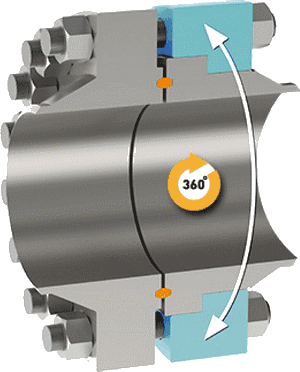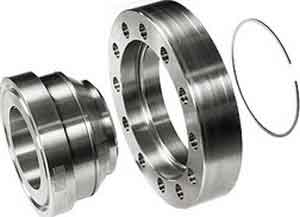The Swivel Ring Flange is comparable to a set of stub end and lap joint flange, with the difference that an Swivel Ring Flange is used for higher pressure and mostly in offshore / subsea applications.
The swivel ring flanges adjust for bolt hole misalignment in the field via rotational adjustment of the bolt hole pattern on the flange ring relative to the spool piece.
The Swivel Ring Flange is of two piece construction consisting of a heavy forged welding hub with a rotating forged ring that serves as a
mating flange to a Weld Neck or other flange. It has a Retaining Ring to secure the Welding Hub to hold the Rotating Ring in position.
These versatile flanges are utilized in many applications and are used extensively in offshore piping where they solve the issues associated with the alignment of bolt holes during subsea flange installation.
 360° rotational swivel ring simplify bolt alignment
360° rotational swivel ring simplify bolt alignment
Ratings
The pressure-temperature ratings and basic dimensions (OD - bolt circle - facing - number and size of bolts) of Swivel Ring Flanges, in Class 150 through Class 2500, are identical to ASME B16.5 and MSS SP44 Flanges and will readily mate to a standard weld neck flange. Ring type joints (RTJ), raised face, flat face and other facings are furnished as required. Sizes up through 60 inch including flanges to mate to ASME B16.47 dimensions are available.
Materials
Standard materials are A105 with a minimum yield of 42,000 psi and additional thickness is provided at the welding end to compensate for higher yield pipe. These flanges can be furnished in higher yield materials such as ASTM A694 or ASTM A707 and are also supplied to customer specifications.
Remark(s) of the Author...
Swivel Ring Flange Standard
There are no industry guidelines specifically suited for Swivel Ring Flanges design and manufacture of these flanges. As a result, the swivel ring flange is often designed, manufactured, and sold to offshore operators as little more than a commodity item.
A wide disparity in design criteria has developed between the various swivel ring flange manufacturers. Some manufacturers do not fully appreciated the extra-ordinary stresses experienced by this product. Some swivel ring flanges have failed during initial installation. Others failed later, when additional external loads were applied to the pipeline. The failure can be relatively minor, consisting of product leakage past the RTJ gasket. In the worst cases, the flange failed catastrophically, causing a sudden, violent separation of the flange ring from the hub component. Read more at: Offshore
Because there is no standard available, the design can differ per manufacturer. I have found on the internet countless manufactures and suppliers.
Most refer to ASME or MSS standards. I have checked on May 2019, latest standard's of ASME B16.5, ASME B31.1, ASME B31.3 and MSS SP44, and can't find anything about Swivel Ring Flanges.
Of course, most dimensions will correspond to e.g. Welding Neck flanges acc. to ASME B16.5, in order to make a STANDARD connection, but other criteria are determined by the manufacturer himself.
I don't want to say that the several manufactures have wrong design criteria but: A new industry standard would certainly make sense.



